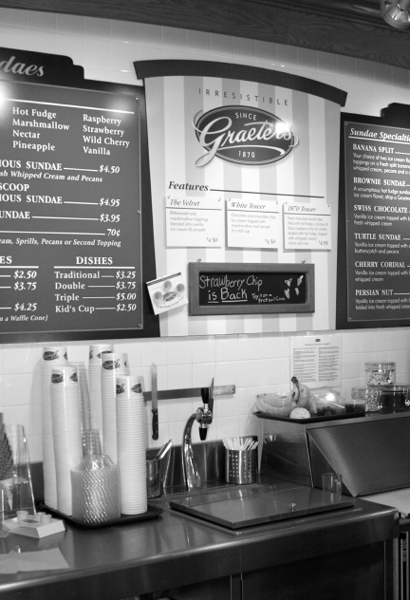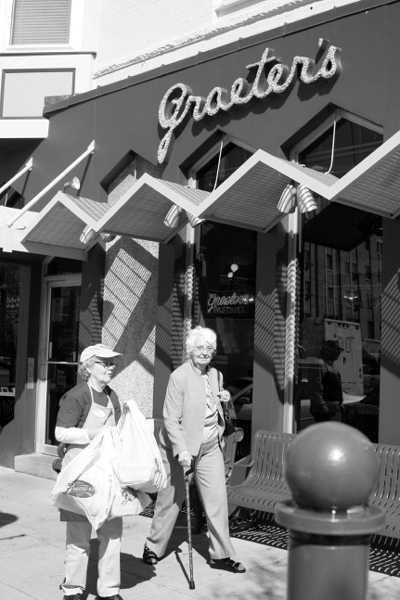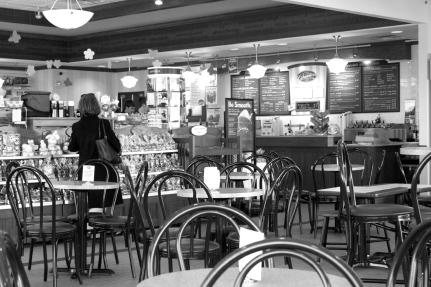Greater's Ice Cream (10 page)
Read Greater's Ice Cream Online
Authors: Robin Davis Heigel
Tags: #Graeter’s Ice Cream: An Irresistible History


The West Chester store, which opened in 2008, shows off the new logo and color scheme.
Courtesy of Ken Heigel
.
Despite the tough transition between generations, the third generation recognizes the benefits the fourth generation has brought to the company, things they had never done themselves. “I think they're doing a lot better job in marketing and advertising,” Lou said.
Dick agrees. “We just didn't do that. I think our generation was pretty old-fashioned,” he said. “We did a little advertising but we always felt the product sold itself. Any new stores now have a lot of the same features as the other stores, where for years we just put a store up. We just made it fit the community or whatever. There was no continuity of branding or whatever. Now they really have stepped that up.”
Part of the changes and expansions have been necessary to keep the family business in the family. “We sold enough to make a good living for our family. Then of course we got more family. And we had to do more,” Dick said.
Part of doing more means deciding what products to keep, including different ice cream flavors, based on sales. “There were flavors that came and went. If it did well, we kept it,” Dick said. “This group does everything by the numbers. If it sells 1 percent, they drop it.”
His son, Richard, doesn't disagree. “We don't keep as many unpopular flavors anymore.” Richard and Dick didn't always agree on what flavors to bring to market, either. When Ben & Jerry's introduced cookie dough ice cream in the '80s, it became so popular with consumers that other ice cream makers started imitating it within months. But Dick wasn't interested in making a Graeter's version of cookie dough or cookies and cream, another popular flavor of the time, because they were what he called “popular” flavors. Richard saw an advantage in making Graeter's versions of these flavors, and he saw them through to market.
“Cookie dough ice cream made
our
way with
our
chocolate chips. And our cookies and cream made our way, which is buying whole Oreos instead of itty-bitty broken pieces,” Richard said. “They're some of our bestsellers still.”
Richard also points out that while Dick has strong opinions about Graeter's Ice Cream flavors, he isn't the company's ideal customer. The majority of Graeter's customers are kids and moms.
In addition to a new physical look, the three new owners took a long-term look at the company and their goals. Richard, Chip and Bob hired consultants Robin Guiler and Paul Porcino, who had decades of business experience at Procter & Gamble and Lens Crafters, respectively. Guiler and Porcino facilitated a series of retreats in 2007 that helped Richard, Chip and Bob come up with a mission, core values and strategic direction, something that most companies start with when they're formed but that the Graeters had never set down.
The mission is simple: “To make the best ice cream you have ever tasted.” It is, Richard says, more than a phrase that hangs in a frame on the wall. It's what the Graeters go back to over and over every time they want to make a company decision.
With the mission in place, they came up with core values: 1) their heritage, 2) their products, 3) their customers, 4) their employees and 5) their community.
For strategic directions, the trio agreed on: 1) to create and maintain a professionally run company with sustainable profitability, 2) to develop and sustain a highly qualified, performing employee base, 3) to improve the Graeter's experience through people and facilities, 4) to optimize the Cincinnati operating company and 5) to exploit the growth potential of the brand in new geographic markets.
With all of these foundations in place, it was easy to see on what areas the company needed to focus its attention.
One of the first was with employees. First, Richard, Bob and Chip brought Guiler and Porcino on as full-time consultants in crucial roles in the company. In an article in
Smart Business
, Richard said, “In the past, you had the employee members and you had Graeters, and that was that. There was no in between.”
Guiler and Porcino fill a gap, bringing talents to the company that Richard, Bob and Chip don't have. Under Guiler's and Porcino's guidance, the company embarked on training programs that gave employees, from managers to part-time store workers, the skills they needed to succeed. When employees completed training, they were eligible for raises and promotions. In addition, all workers are offered paid days off and health insurance.
“We have employees that have stayed with us for their lifetime,” Richard said. The fourth generation wanted to keep that momentum while also giving the employees a chance to succeed and grow.
Another area that required attention was production efficiency. To improve it, Graeter's started running three shifts of ice cream making instead of two. They worked out a schedule of workers so they never had to shut down during a shift. They dedicated certain crew members to clean up and tear down. They became diligent about maintenance, to keep the machines operating at top form all the time. The improvements were dramatic.
“The year I started in the business we were making 100,000 gallons,” Richard said. “In 2004, we were making 200,000.”
In 2007, Richard also expanded relationships with his dairy suppliers, Trauth Dairy of Newport, Kentucky, and Smith Dairy of Orville, Ohio, turning them into distributors of Graeter's Ice Cream. Now, along with other brands, the dairies, as well as UDF, include Graeter's Ice Cream in their trucks delivering ice cream to various locations.
“Distribution was a competency we did not have. You have to know what you're doing,” Richard said. “When you're only a niche product, it is almost impossible to develop the necessary distribution system. At one time, my bakery drivers would drop off product at the country club while delivering.”
Now, the dairies, along with UDF trucks, distribute Graeter's to grocery stores.
All the changes and transitions set the family on the path for a brighter future.
Today, Cincinnati houses a population of more than 300,000 and more than 2 million people if surrounding areas are included. It is the third largest city in Ohio, behind Cleveland and Columbus. It is home to numerous businesses, including Procter & Gamble, Kroger, Federated Department Stores (owner of Macy's and Bloomingdale's) and Chiquita Brands International.
Over the years, the city has been the birthplace of many famousâand some infamousâpeople, including abolitionist Harriet Beecher Stowe, entertainer Doris Day, film director Steven Spielberg, crooner Rosemary Clooney, pop singer Nick Lachey, talk-show host Jerry Springer, disgraced Cincinnati Reds player and coach Pete Rose and mass murderer Charles Manson.
Cincinnati was the home of one of the worst rock concert tragedies in U.S. history, when eleven fans were killed and dozens injured in a rush for seating at a sold-out concert by The Who at Riverfront Coliseum in 1979.
The city again drew national attention when the Robert Mapplethorpe photo exhibit opened at the Contemporary Arts Center in 1990 and its director, Dennis Barrie, was indicted on obscenity charges because of the graphic sexual nature of the photographs. Barrie was acquitted of the charges later that year, though the trial brought the question of what constitutes art to the national forefront.
Race relations remained an ongoing challenge for the city. Riots broke out in 2001 after an unarmed black man was shot, and the police department was accused of racial profiling. Many people feel these riots cost the city its bid to host the 2012 Summer Olympics.
At the same time, however, the National Underground Railroad Freedom Museum honoring the city's important work on the Underground Railroad was being planned. It opened in 2004, and to date, it has brought in almost one million visitors from across the country and around the globe.
Cincinnati Reds owner Marge Schott, who died in 2004, caused her own race relation debacles over and over in the '90s with her racist comments and professed admiration of Adolf Hitler. These views led to her one-year suspension by Major League Baseball and overshadowed her acts of kindness and generosity.
Beloved Riverfront Stadium was demolished in 2002 to make way for a new ballpark. The Great American Ball Park, where the Reds play, opened a year later, built next to the site where Riverfront had stood. It is smaller than Riverfront, seating just over forty-two thousand, but is praised for its breathtaking views and innovative features, including Italian marble mosaics and a riverboat deck, as well as its tribute to Reds' history.
The Cincinnati Bengals, who had shared Riverfront with the Reds, got their own new football stadium down the street: Paul Brown Stadium, named for the team's original owner.
Paul Brown holds sixty-five thousand people. The Astroturf of Riverfront has been replaced with FieldTurf, an artificial surface that more closely mimics natural grass. The Bengals, who went to the Super Bowl twice in the '80s, have yet to win the World Championship.
Through the decades, Cincinnati has also developed its own food culture, including Skyline Chili, which started in 1949 and serves its thin chili (with more aromatic spices than fiery heat) over spaghetti or on hot dogs topped with a cyclone of thinly shredded cheddar cheese. La Rosa's Pizza, with its sweet tomato sauce and crispy crust, started in 1954 and has become an institution, as has Montgomery Inn, known for its fall-from-the-bone, sweet-smoky barbecued ribs. The restaurant started in Montgomery north of Cincinnati in 1951 and now has a location on the Ohio River downtown, as well as one in nearby Fort Mitchell, Kentucky, and Dublin, a suburb of Columbus. (By the way, Montgomery Inn serves Graeter's Ice Cream for dessert.)
Through it all, the Queen City has remained home to Graeter's Ice Cream, one of the oldest family-owned ice cream businesses in the country.
The company still offers eight “original flavors,” including black cherry, coffee, strawberry and butter pecan, and a handful of sorbet flavors, such as strawberry. In addition, Graeter's makes ten of its ever-popular chocolate chip flavors, including Buckeye Blitz, toffee chocolate chip and, of course, the customer favorite, black raspberry chocolate chip. Seasonal flavors such as pumpkin, cinnamon, peach and tangerine rotate in and out during certain months.
The retail stores continue to offer many of the same sodas, milkshakes and sundaes they've made for nearly one hundred years. Now there's also a signature sundae commemorating the company's history: the 1870 Tower. It features a chocolate bundt cake filled with hot fudge and a scoop of black raspberry chocolate chip ice cream, drizzled with more hot fudge and then topped off with whipped cream, chopped pecans and a cherry.

The oldest Graeter's store in Cincinnati sits on Hyde Park Square.
Courtesy of Ken Heigel
.

The West Chester store combines the new look and feel with the same old-fashioned charm.
Courtesy of Ken Heigel
.
In the Cincinnati area, Graeter's Ice Cream has fourteen retail stores. In Kentucky there are fourteen stores plus two in Indiana, owned by two franchises. The Columbus area has eleven stores, plus another four that the same franchise opened in Dayton. One Columbus store and two Dayton locations are housed in the same building as another Ohio favorite: City Barbecue.
